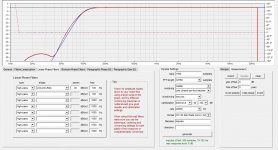I am interested in a high pass filter that has a sharp cutoff at 100 Hz.
The reason is that i want theelement to have as low cone amplitudes as possible, not to 'disturb' higher frequencies.
I will have a (sub)bass element playing under 100 Hz.
I have used the ScanSpeak excel sheet that shows cone amplitude of a given element and boxsize. (5liter closed box 5.5 inch revelator.)
As you se from picture 1, the cone amplitude go down at approx. 12 dB/oct from 50 to 150 Hz.
A 12dB/oct filter only about straightens the curve so that 50Hz sine at same level gives the same curve amplitude as a 200Hz sine.
Picture 3 shows a 24dB/oct filter and it gets better, but still a 70Hz sine gives quite a large extra cone amplitude.
So I'm thinking 48dB/oct gets rid of most cone amplitude from spectre under 100 Hz.
But then I get into the delay/latency trouble.
A 4 pole IIR 24dB/oct has 6 ms group delay. picture 5
A 8 pole IIR 48dB/oct has 14ms group delay, picture 6
According to Iowa hills the filters can be analog and still the delay will be there.
Going to FIR just makes matters worse. But then a really sharp filter can be made for the upper mid, picture 8
Do enyone know if science now have defeated old paradigmes and made digital filters with shorter group delay than their analog counterparts?
That is: Can i make a Linkwitz 48dB/oct HP filter with lower group delay than 14 ms to watch TV without lipsync trouble🙂
Regards Torgeir
The reason is that i want theelement to have as low cone amplitudes as possible, not to 'disturb' higher frequencies.
I will have a (sub)bass element playing under 100 Hz.
I have used the ScanSpeak excel sheet that shows cone amplitude of a given element and boxsize. (5liter closed box 5.5 inch revelator.)
As you se from picture 1, the cone amplitude go down at approx. 12 dB/oct from 50 to 150 Hz.
A 12dB/oct filter only about straightens the curve so that 50Hz sine at same level gives the same curve amplitude as a 200Hz sine.
Picture 3 shows a 24dB/oct filter and it gets better, but still a 70Hz sine gives quite a large extra cone amplitude.
So I'm thinking 48dB/oct gets rid of most cone amplitude from spectre under 100 Hz.
But then I get into the delay/latency trouble.
A 4 pole IIR 24dB/oct has 6 ms group delay. picture 5
A 8 pole IIR 48dB/oct has 14ms group delay, picture 6
According to Iowa hills the filters can be analog and still the delay will be there.
Going to FIR just makes matters worse. But then a really sharp filter can be made for the upper mid, picture 8
Do enyone know if science now have defeated old paradigmes and made digital filters with shorter group delay than their analog counterparts?
That is: Can i make a Linkwitz 48dB/oct HP filter with lower group delay than 14 ms to watch TV without lipsync trouble🙂
Regards Torgeir
Attachments
-
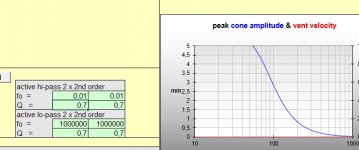 NoFilter.JPG41.7 KB · Views: 206
NoFilter.JPG41.7 KB · Views: 206 -
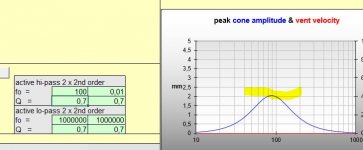 12dBoct 100 Hz q07.JPG41.7 KB · Views: 203
12dBoct 100 Hz q07.JPG41.7 KB · Views: 203 -
 24dBoct 100 Hz q05.JPG37.6 KB · Views: 212
24dBoct 100 Hz q05.JPG37.6 KB · Views: 212 -
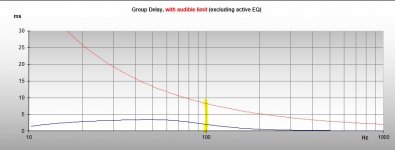 groupdelay no filter.JPG42.5 KB · Views: 204
groupdelay no filter.JPG42.5 KB · Views: 204 -
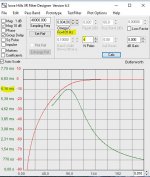 4pole24dBoctButt100hz.JPG65.8 KB · Views: 219
4pole24dBoctButt100hz.JPG65.8 KB · Views: 219 -
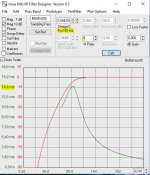 8pole48dBoctButt100hz.JPG66 KB · Views: 147
8pole48dBoctButt100hz.JPG66 KB · Views: 147 -
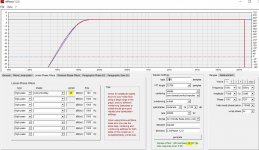 FIR30ms100Hz48dBoct.JPG157.3 KB · Views: 111
FIR30ms100Hz48dBoct.JPG157.3 KB · Views: 111 -
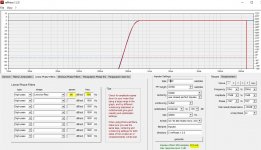 FIR12p5ms600Hz96dBoct.JPG155.4 KB · Views: 105
FIR12p5ms600Hz96dBoct.JPG155.4 KB · Views: 105
Higher order, and sharper filter for a given order, will have higher amounts of group delay. This is due to higher and higher Q second order sections in the overall filter transfer function as order increases. Lower order and lower Q sections for a given order have lower group delays but as you see they will not attenuate as fast as a higher order filter. Welcome to the tradeoffs in loudspeaker design.
If you are doing FIR you can eliminate group delay alltogether but you will need a lot of taps for a 100Hz filter.
I would not use a higher than 4th order filter for your purpose. That will attenuate cone excursion by 12dB/oct below 100Hz, and that should get you what you are after.
Also, keep in mind that the brain is most sensitive to group delay (to below 1msec) around 1kHz, but at the high and especially low extremes of the hearing range (e.g. 100Hz is low in this sense) it is much less sensitive. 14msec is not low, but I highly doubt there will be any perceived lipsynching problems! And remember this is just around 100Hz, and in the band where it counts for timing perception your filter will have no effect.
If you are doing FIR you can eliminate group delay alltogether but you will need a lot of taps for a 100Hz filter.
I would not use a higher than 4th order filter for your purpose. That will attenuate cone excursion by 12dB/oct below 100Hz, and that should get you what you are after.
Also, keep in mind that the brain is most sensitive to group delay (to below 1msec) around 1kHz, but at the high and especially low extremes of the hearing range (e.g. 100Hz is low in this sense) it is much less sensitive. 14msec is not low, but I highly doubt there will be any perceived lipsynching problems! And remember this is just around 100Hz, and in the band where it counts for timing perception your filter will have no effect.
Scan speak suggests max 8 ms group delay at 100Hz, picture 4.
From: Toolbox – Scan-Speak A/S
The 2. order HP filter of the element and the box gives about 2 ms groupdelay, picture 4.
So I'm only left with 6 ms. Then 24db/oct and 6ms groupdelay is all I can "afford"
When I look at FFT of popular music I often see almost a 6db/oct slope from 50 to 150 Hz. So that leaves me with more low frequency cone amplitude than I like for real low THD at mid frequencies.
Yeah, it's a tradeoff unless the groupdelay can be avoided or I axcept more total delay.
From: Toolbox – Scan-Speak A/S
The 2. order HP filter of the element and the box gives about 2 ms groupdelay, picture 4.
So I'm only left with 6 ms. Then 24db/oct and 6ms groupdelay is all I can "afford"
When I look at FFT of popular music I often see almost a 6db/oct slope from 50 to 150 Hz. So that leaves me with more low frequency cone amplitude than I like for real low THD at mid frequencies.
Yeah, it's a tradeoff unless the groupdelay can be avoided or I axcept more total delay.
Last edited:
Correct me if I'm wrong, but this is a phase delay you are talking about? I'm not sure it would be audible, especially as a time delay that would cause sync problems?
Well, both Iowa Hills and Scan-speak and most others calls it group delay.
https://en.wikipedia.org/wiki/Group_delay_and_phase_delay#Group_delay_in_audio
So its not phase delay, even if they relate to each other.
I was too stringent on the lip-sync delay as it can be 22 ms or maybe more.
https://en.wikipedia.org/wiki/Group_delay_and_phase_delay#Group_delay_in_audio
So its not phase delay, even if they relate to each other.
I was too stringent on the lip-sync delay as it can be 22 ms or maybe more.
Took another look at the different windows in rephase.
If I accept 20 ms delay, I can have close to 48dB/oct almost linear phase FIR at 100 Hz.
lanczos has done the job for me.
Think I am home free🙂
If I accept 20 ms delay, I can have close to 48dB/oct almost linear phase FIR at 100 Hz.
lanczos has done the job for me.
Think I am home free🙂
Attachments
Last edited:
Thanks for the link, it's an interesting subject, Rod Elliott explains it and puts it into perspective quite well too. From what I can gather it's an inherent part of how a filter works and that's why a lot of people prefer as shallow a filter as will get the job done.
Yes, it is easy to forget about the group delay when sharp filtering is so easy to obtain with the crazy powerful DIY DSP tools available today.
I remember when graphic equalisers were first used in the home, not pretty results! I've yet to go down the digital route, I've found it tempting at times, so I don't know what can and can't be done, seems to me from observation it is still, largely, work in progress.
- Status
- Not open for further replies.
- Home
- Source & Line
- Digital Line Level
- What is lowest group delay or latency for high pass, 100 Hz, 48 dB/oct filter?
